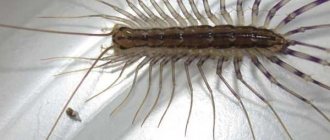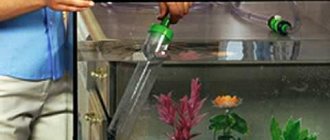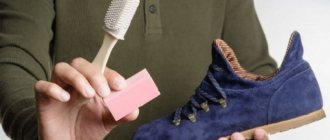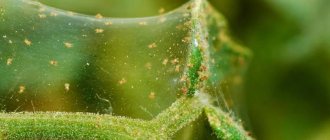The bedbug (lat. Cimex Lectularius) is a type of bedbug, an obligate synanthropic blood-sucking insect, an ectoparasite of humans and warm-blooded animals, feeding only on blood. It is called “bed” because its favorite habitat is the human bed. The second unofficial name for these parasites is “room bugs”; They are called so because of their direct dependence on a person and his home. Belongs to a type of arthropod from the class of insects, the order Hemiptera, they cannot fly.
Let's consider the characteristics of bedbugs, their lifestyle and impact on humans, as well as methods of combating this domestic parasite.
What does a bed bug look like?
The appearance of a bedbug is characterized primarily by a flattened body, which helps it get between fabric folds without the risk of being crushed by a person. The length of the bug is from 3 to 8.5 mm, depending on gender and blood saturation; females are larger in size than males. Body color ranges from dark brown to dirty beige and even rusty.
In addition to the proboscis for piercing the skin, the bug has sharp bristles for secreting anesthetic saliva into the bite site.
Photo of a bug under a microscope. A proboscis emerges from the front of the head to pump out blood.
Bedbugs are most active at night, especially when they are hungry. A well-fed bedbug increases in size, becomes less agile and more vulnerable; it is the well-fed, crushed bedbugs that leave blood marks on the pillowcase.
Traces of blood may remain on the pillowcase if you crush a well-fed bug in a dream.
Who is a friend, who is an enemy, and who is just for fun?
Like any living organism, there are harmful ones and there are useful ones. Also with bedbugs. Someone helps a person and preserves his harvest, and some not only strive to ruin the entire harvest, but also feast on the blood of its owner.
Bed bugs are beneficial (harmless)
These individuals are often identified by their coloring. It is designed specifically for repelling. Some types of bedbugs in the photo look like they are specially decorated. The line bug is a frequent visitor to home gardens and front gardens. A black and red small body, like lines drawn under a ruler. With all his appearance he “screams” - don’t come near!
His main task is to examine all umbrella plants in search of food. Dealing with it will not be difficult - assemble it manually.
Soldiers are the most common victims of children. They catch them and arrange obstacle races for them. The wingless redbug is the correct name for this insect. Hides at the roots of trees, stumps and dry grass. He finds food right there; everything suits him, from seeds, ants, eggs, larvae, dead insects and the remains of living organisms. Useful in your garden as a sanitation worker.
The bug Perillus, It was brought to Russia from Mexico on purpose. He is a threat to the Colorado potato beetle and many other “undesirable” insects. The main target is the eggs of the potato pest.
Flower bugs are specially bred to kill pests indoors. They feed on plant pests - aphids, mites, insect larvae and eggs.
Predators are the number one enemy of beetles that cause damage to agriculture. They live in abandoned houses and basements, finding food and shelter there.
Bed bug lifestyle
The bug leads a parasitic nocturnal lifestyle; both females and males with larvae feed on blood. The main time for an attack on a sleeping person is from 3 to 8 am. During the day, these insects hide in the mattress, under the wallpaper, behind the baseboards, in books, in clothes and beds. During the day they come out into the light extremely rarely, only in case of severe hunger. They are able to move from one room to another through ventilation systems, as well as along walls both inside and outside the apartment. The speed at which an adult bedbug travels 1 meter is 1 minute.
Bedbugs have a well-developed sense of smell, which helps them find victims and places of shelter. For example, they can smell the clothes you wear most often, such as a dressing gown, and hide in it.
What do bed bugs eat?
Bed bugs feed exclusively on blood. They do not need water and food to live, like cockroaches. Not only females drink blood (like mosquitoes), but also males with larvae.
An adult can drink up to 7 mg of blood at a time, and a larva can drink less than 1 mg. Parasites feed approximately once a week. If a person is not nearby, they can bite cats, dogs, rodents and even birds.
How long do bed bugs live?
The average lifespan of a bed bug is 1 year. In extreme situations, for example, in the event of a sudden cold snap or a person leaving the apartment for a long time, they can fall into a state of hibernation and spend more than a year in it.
At what temperature do bedbugs die?
Temperature at which bedbugs and their clutches die: +50˚С (temperature must be maintained for at least 10 minutes).
Negative temperature at which a colony of bedbugs dies along with their eggs: -25˚С (the temperature must be maintained for at least 2 hours). Frost down to -10˚C is practically not scary for bedbugs; they simply hibernate.
Comfortable temperature for bed bugs to live and reproduce: +20-30˚С. This is the temperature maintained in apartments and private houses.
Lifestyle
Bedbug Habitat Despite the fact that the bedbug does not have wings and cannot fly, it moves easily, climbing onto the ceiling and walls, after which it glides safely. Insects are nocturnal, and during the day the habitat of bedbugs is:
- bed;
- mattress;
- sofa;
- other pieces of furniture;
- books;
- cracks;
- cloth;
- Appliances.
They like to hang out where it is dry and warm. They can live not only in dirty apartments, but also in rooms that are always kept clean. But when bedbugs are active, it is between three o’clock in the morning and eight in the morning. If they are very hungry, they may well attack a person under artificial light.
Even in an empty apartment, bedbugs live for about a year. If the room temperature is low or the bloodsuckers are hungry, they can enter a state resembling suspended animation. Bed bugs migrate quietly if living conditions are not suitable for them. In one minute, an adult can crawl about 1.25 m, and a larva - about 25 cm. In 10-15 minutes, they can drink blood in an amount twice their weight.
The parasites are very tenacious and can withstand temperatures up to + 49°C. If there are pets in the house, they can become prey for bed bugs. They mainly like to bite children and women. Insects have a very thin proboscis with two channels. One day after immersing itself in the skin, the parasite introduces an enzyme, thanks to which the person does not experience pain and does not feel how the bug bites. Through the second, it sucks blood. Nymphs are more voracious, unlike large bugs. Their bites are painful, since the saliva has not yet developed a component that can relieve pain.
The insect's larval period takes a month. During the remaining time, the female lays 4-5 eggs daily. On the fifth day, a nymph appears; after a month, she becomes an adult, ready for reproduction. The bedbug feeds once every 5-10 days.
The question of what bedbugs are for also often arises among people. In ancient times, they were credited with healing properties - supposedly bedbugs could neutralize snake venom. This has not been scientifically proven. But the fact that they are eaten by cockroaches, flies, spiders, centipedes, and ticks is a proven fact.
Reproduction and development of bed bugs
Mating of bedbugs occurs through traumatic insemination: the male pierces the female’s abdomen with his genitals and injects seminal fluid there. After a couple of weeks, the female begins to lay eggs, up to 5 eggs per day. Over the course of her life, a female can lay 250 to 500 eggs.
The development of an insect from an egg to the adult stage takes 30-40 days, and under difficult conditions (for example, at low temperatures) up to 100 days. The larvae immediately begin to look for food, they need to drink a whole portion of blood in order to move to the next stage of development and undergo molting.
general information
Before looking at bedbugs in detail, it is worth mentioning the basic characteristics and nomenclatures that apply to these living creatures. House bugs are:
- Insects.
- Parasites that feed exclusively on human blood. They are not interested in pets and other representatives of the animal world as a source of food.
- Insects with a complete life cycle of development. The female lays eggs from which a young bug emerges, which is usually called a nymph. Molting several times, the nymph turns into an adult sexually mature individual.
Other details from the world of bedbugs are in the following sections.
Differences between bedbugs and other insects in the house
Male bedbugs also feed on blood, although in some insect species only females feed on blood in order to be able to reproduce.
Bed bugs are often confused by name with bed dust mites. Dust mites are very small and cannot bite through human skin; they live in pillows and other parts of furniture. They feed on microscopic particles of skin that fall off our bodies. It is unlikely that you will be able to see a dust mite with the naked eye, but it still causes harm: a person can develop an allergy from its waste products, which is confirmed by tests, and this is what is written in the diagnosis “dust mite allergy.”
Dust mite under a microscope
Unlike ants, bedbugs do not build nests and do not form colonies; they prefer to randomly accumulate near a food source, usually near the place where a warm-blooded living creature spends the night. Ants do not feed on human blood, but can only bite in defense.
Unlike fleas, bedbugs are larger in size and cannot jump. Traces of their vital activity are easier to detect than to understand that there are fleas in the apartment. Scars from flea bites most often appear on the legs, in contrast to marks from bedbugs, which can also cover the upper body.
Special signs
When a room is infested with bed bugs, you can navigate by one of the manifestations of the parasites. This is due to the fact that each of the signs differs from traces of contact with mosquitoes, fleas, lice and other blood-sucking insects
However, sometimes you need confirmation of your own fears, so pay attention to other signs
Characteristic bites
This is the main sign of bedbugs in an apartment, since it can be noticed immediately after an object is infested. For comparison, other manifestations become visible only after some time. Contact with bed bugs produces red spots of varying sizes. Some people do not have such a symptom; only invisible red dots remain on the body.
Bedbug bites can be easily distinguished from the bites of other insects.
Other symptoms of bed bug bites:
- itching, and its intensity is quite high, and scratching occurs on the body;
- swelling, as a result of which bumps are found in the areas where the bites appeared, but without compaction inside, the intensity of the swelling depends on the sensitivity of the body;
- the size of the red spots varies from 0.5 to 5 cm, and the tracks of the bedbugs form a straight line - a path, since the parasite makes several punctures per meal, moving forward every few centimeters.
Other symptoms appear less frequently: pain, fever, headache, chills.
Chitin shells
There are many signs of bedbugs appearing in an apartment, but in second place is the detection of husks, which are shed by the larvae after each molt. A young individual of the pest changes its shell up to 4 times. This happens at different intervals - from 7 to 14 days or more, depending on environmental conditions. The shell can be seen on the floor or other surfaces, as it is distinguished by its light brown color. Moreover, the outer covers are transparent.
Chitinous shells shed by bedbugs during molting
Clutches of eggs
A female bedbug lays up to 5 eggs per day. To provide the offspring with protection, she leaves them not only in the nest, but also in different parts of the room. If one clutch is destroyed, for example by human discovery, the remaining eggs remain intact. The offspring at this stage look like small white formations - up to 1.5 cm in length. On one side there is a lid that allows insects to escape from the shell when necessary.
Clutches of bedbug eggs: not a single infected object can do without them
Specific smell
If bed parasites have only recently appeared, this sign is absent. The smell is felt when the number of pest colonies increases to several hundred individuals. This is a consequence of the vital activity of parasites. They leave excrement and secrete other secretory fluids in minimal quantities, but as the number of insects increases, a large amount of excrement accumulates in the apartment, which contributes to the appearance of a smell reminiscent of old cognac. If you stay in the room for a long time, you won’t feel it.
The specific smell of bed bugs is a guarantee that there are insects in the apartment
Blood stains
Such signs of bedbugs are also detected if there are a lot of parasites at home. Dots or small specks of blood appear on the bed if a person accidentally crushes the parasite in a dream. This occurs due to an increase in the volume of the insect’s body after eating. As a result, the parasite is much easier to kill. His body becomes more pliable and breaks easily. For comparison, in a hungry state it is more difficult to destroy a pest mechanically.
Blood stains from squashed bedbugs remain on the bed
Traces of bedbugs on the wallpaper
If red spots remain on the bed linen, then on the finishing materials only stains from excrement, as well as other secretory fluids of parasites, appear to a greater extent. You can see traces of a bug on the wallpaper when the insects have built a nest in the area where the material has moved away from the wall. Parasites penetrate under any covering.
In particularly infested areas, traces of bedbugs are even present on walls and wallpaper.
Vital signs
When parasites colonize an apartment, black dots are found on different surfaces, and more often in areas where nests are located. This is parasite excrement. Bed bugs feed on blood, which is why the stool turns dark. The blackheads are small in size, which is why they resemble poppy seeds. The larger the pest nest is, the more things deteriorate in the area where it is located.
If furniture is infested with bedbugs, it is practically beyond repair.
How to determine that there are bedbugs in an apartment?
It is not difficult to determine the presence of bedbugs in a private house, apartment or dorm room; pay attention to the following signs of their presence:
- Black dots on the mattress, sheets, under the pillow - dark-colored bedbug feces that look like traces of a black pen or felt-tip pen. Make a light bed, this will make it easier for you to detect the presence of parasites, and the traces will be washed off.
- Eggs, full or empty, as well as fragments of the shell of the bedbug larva, which it sheds, moving to the next stage of development.
- Traces of multiple bites on the body. The bug bites not just once, but several times, so many bites will be noticeable on one area of the skin. You are unlikely to be able to feel the moment of the bite, because the bug injects a “painkiller” under the skin.
- A visual inspection of the bed at night will show whether there are bloodsuckers in it. Set your alarm for 5am, get up, turn on the lights, and examine your bedding.
Interesting Facts
Residents of apartment buildings should know some signs of the presence of linen bloodsuckers indoors:
- The bug has an odor reminiscent of coriander.
- An indisputable sign of the presence of insects is complaints from family members about the appearance of numerous bites located on the body.
- Peak food intake for parasites is from 0:00 to 05:00 hours.
- An insect that feeds on blood can go without food for 2 months.
- An adult quickly finds a food source, because senses the warmth of the human body and the presence of carbon dioxide in the exhaled air.
- A bug bite causes an allergic reaction in 80% of people.
- The insect is often the cause of anemia in young children.
- Triatomidae are carriers of the causative agent of Chagas disease or American trypanosomiasis.
- An increase in the number of blood-sucking parasites is facilitated by the formation of populations resistant to the effects of insecticides, for example, 25% of cypermethrin, which is part of disinfectants.
There are many ways to combat home bugs, which allow you to destroy all blood-sucking insects living in the room.
Causes of bedbugs in the house
Many people think that bedbugs only grow in dirty, unkempt rooms, but this is not true. They are able to take root in any room, regardless of the sanitary situation. Where do they come from? List of main reasons:
- from neighbors who allowed unsanitary conditions in the apartment;
- from pets walking on the street;
- from a hotel or hostel, they can come home with you in a suitcase with clothes;
- from used furniture or equipment, purchased on Avito or brought from the trash.
Interestingly, bedbugs cannot independently move along the street from one private house to another. Therefore, if bedbugs have appeared in a private home, be sure that you brought them yourself on some things, furniture or clothing.
Is it possible to protect your home?
100% ways to protect homes from bedbugs have not yet been invented. They can enter the apartment through the hood or through cracks in the slabs. Of course, you can secure the ventilation grilles by covering them with a thick mesh and sealing the cracks. But no one is immune from “picking up” a bedbug in a hotel, public transport, or while visiting.
The only thing that can be protected is the bed and mattress. This can be done by using special traps and a protective cover of the HECTOR brand.
The traps have a rough outer surface that abruptly turns into a groove with smooth walls. Each of the bed legs should stand inside such a trap. Since bed bugs are insects that can only crawl, the only way into your bed is through the legs of the bed.
Protective mattress cover Hector It is a completely sealed cover with a micro-zipper. By putting it on the mattress, you will not allow bed bugs to settle inside, which means you will save it in case the apartment is infested with insects. The cover consists of two layers. The inner and most important one is made of a special membrane, ensuring 100% tightness, and the outer one is made of 100% cotton. It is important to note that the membrane of the inner layer breathes well and does not creak.
Also, if your sleeping place is already infested with insects, you can save the mattress, since by wearing such a cover, the bed bugs that are already inside will be “walled up” and they will not have access to food.
Favorable conditions
The conditions in the apartment are suitable for the existence of bedbugs: in urban housing there are no sudden temperature changes, optimal heat and humidity are maintained. The sanitary condition of the premises does not play any role; in any housing there are many secluded places for building a nest.
Bed bugs love warmth, it stimulates their vital activity, so they reproduce most actively in the summer. A comfortable temperature for the parasite is 20-25 °C. Darkness is important for hunting
The most important condition for a prosperous existence is a source of food (human) and quick access to it
A nest of bed bugs in the sofa.
Harm from bed bugs to humans and animals
In addition to irritation and redness of the skin, inflammation may also appear at the sites of bedbug bites if an infection occurs during resorption. Multiple bedbug bites can lead to the development of an allergic reaction and the appearance of a rash, as a result of which the affected skin will be very itchy and interfere with a full life.
There is an opinion that bedbugs carry dangerous diseases such as typhoid, smallpox, and hepatitis. But the facts of infection have not been proven.
For pets, severe harm from bedbugs is also unlikely; bald spots may appear due to the pet scratching the bite site.
Offspring
Despite the fact that bedbug eggs are very small (about 1 mm), and they themselves are difficult to notice, the female lays them in secluded places and carefully hides them. After a few days, a larva appears or, as entomologists call it, a nymph. To understand what bedbug larvae look like, just look at an adult. A nymph is an exact copy of her, only smaller in size.
The larva grows very quickly. With plenty of nutrition and comfortable temperature conditions, it reaches its adult state within a month. During development, the larva molts several times (sheds its chitinous shell).
Interesting! Nymphs cause particular discomfort to humans. They do not know how to inject an anesthetic substance into the bite site, so during feeding it is their bites that people feel at night.
Symptoms of bed bug bites
The symptoms are individual for everyone: some do not notice them until they see red dots on the body, while others begin to experience severe discomfort due to itching. Unlike a mosquito bite, the mark of a bug remains longer and is distinguished by bright redness with characteristic compaction and swelling.
You can only feel the moment of the bite if the larva is biting, because it has already developed an anesthetic secretion.
In another article, we described in detail how bedbugs bite. The link will open in a new tab.
If the skin is very swollen and the redness has spread far beyond the damage, then you are allergic to bedbug bites. The following symptoms may appear:
- general weakness in the body;
- nausea, vomiting;
- dizziness;
- muscle spasms;
- lack of air.
If you have these symptoms, immediately take an antihistamine and consult a doctor!
If there are no allergies or complications, it will be enough to disinfect the damage with alcohol or soda solution and apply Fenistil or other gel with a healing and soothing effect.
The Gektor company has released a special gel to eliminate marks from bedbug bites. Gel Hector consists of natural ingredients and helps relieve inflammation and prevents scratching of damaged skin. The disinfecting properties of the drug help speed up the healing of wounds, and the nutrients return the skin to a healthy color. A 50 ml tube costs about 230 rubles.
Chemical control methods
When planning to poison bed bugs, you need to remember that they have a high survival rate. And therefore, the most effective chemical control agent can only work once. Then a mutation occurs in the individuals, and they easily tolerate repeated disinfestation with this drug.
Still, chemical treatment of the room is the best way to combat any type of insect. The product used may be:
- Aerosol.
- In the form of a solution.
- Powdery.
A prerequisite when working with any product is to carry out the work in chemical protective clothing. When poisoning insects, you need to wear a mask and gloves. And perform all actions in strict order:
- All bed linen is washed with water above 60 degrees, ironed with a steam generator and hermetically packed in bags.
- Fur clothes, blankets, pillows, mattresses and carpets, everything where insects like to hide, are sent to dry cleaning for processing.
- It is better to burn books and magazines that are of no value. The rest should be sealed for subsequent cold processing.
- The walls and ceilings in all rooms are cleared of wallpaper, ceiling tiles and other similar types of decoration.
- All furniture is moved to the middle of the room to treat the perimeter with a pest control agent.
- Next, all upholstered and cabinet furniture in the house are treated with the product. There is no need to be afraid to spray all things thoroughly. This is the only thing necessary for the remedy to work, and for this method of fighting insects to be effective.
- After treatment, you must leave your home for 4-5 days.
- Upon return, thoroughly wash the floor and perform a wet cleaning.
Effective modern remedies for bedbugs
To be honest, traditional methods, physical and mechanical effects are practically useless in the fight against bed bugs; they will only rid the house of parasites for a short time and force them to take cover for a while. Traditional recipes and herbs are good only for preventing the appearance of insects, but not for removing them.
Modern drugs are very effective and can destroy bloodsucking bedbugs in one or two applications. The most popular and suitable product on the market now is HECTOR powder.
There are quite a lot of reviews on the Internet from people who have dealt with the problem of bedbugs with Hector. From them it is clear that the product really works, but there are several nuances. Due to its powder form, “dust” may form during processing, and it must take at least two weeks to achieve results.
There is an opinion that the most effective way to get rid of bedbugs in an apartment once and for all is to call a pest control service. But, unfortunately, not all services are conscientious about their work. Many of them are aimed only at obtaining maximum profits, saving on the quality of the funds used. Someone deliberately does not complete the treatment so that the client calls the “specialist” again. Now you can easily cope with insects on your own, since all methods and means are freely available. However, the choice is yours.
It is possible to remove bedbugs, but protecting yourself from their appearance is quite difficult, so be attentive to redness on your body and stains on your bed linen, then you can begin to destroy the parasites at an early stage, when they have not yet had time to breed.
Bedbug nests in the photo
Actually, bedbugs do not form organized nests like wasps and especially ants. They simply hide during the day in the most suitable places, and since there are much fewer such places in the room than there are bedbugs themselves, these parasites can accumulate in huge quantities in the most comfortable shelters. In these places there are the bugs themselves, both adults and nymphs of all ages, eggs, remains of the chitinous covers of the larvae, excrement, and in general they look very unpleasant.
For example, here is a typical bedbug nest on a sofa upholstery:
And here the video shows the same accumulation, only on a blanket, which is generally atypical for bedbugs - they prefer to settle on stationary surfaces that are not disturbed by people:
Here is another place for bedbugs to hide, rest and breed, which completely covered one side of the mattress on the bed:
The largest such “nest” that we saw caught the eye of exterminator Kostya in an apartment near Moscow - it was about 80 cm in diameter and was located in the sofa. It is difficult to say how many parasites there were in it, but the sight was, to put it mildly, repulsive.
By the way, this is what a cluster of small larvae looks like right on the mattress:
It was precisely these young individuals that the students we have already mentioned mistook for some strange spiders. But they were definitely sure that these were not bedbugs.
Such hiding places cannot be called nests, because there is no organization or order in them. For example, in the nests of wasps, termites or ants, strict order reigns: the queen lays eggs, the workers look after her, the brood, the nest itself, obtain food, and protect the nest from enemies. All this is not present in bedbug clusters:
- There is no queen that lays eggs alone - all adult females lay them;
- There are no individuals who would maintain order here - everything in such a shelter accumulates spontaneously, complete disorder reigns here;
- The nest is not protected in any way by anyone, and when it is opened, some of the bugs try to run away, the other part hides, hoping that they will not be noticed;
- There is no hierarchy in such a cluster. Bedbugs simply accumulate here, spend daylight hours here, reproduce and die here.
By the way, you have probably already noticed that almost everywhere in such places of accumulation you can see black dots that look like balls. You probably already guessed what it is...











